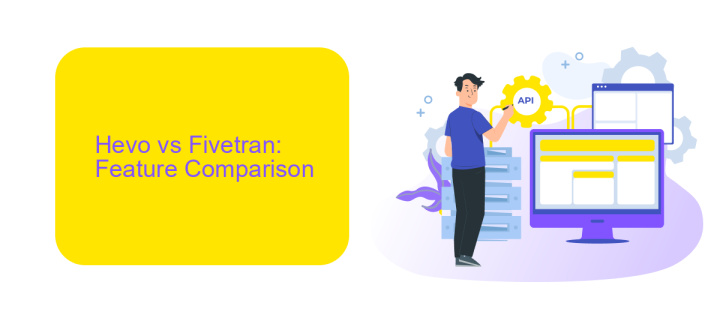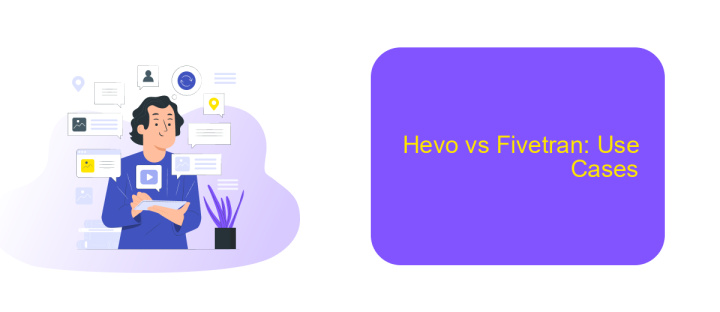Hevo Vs Fivetran
When it comes to data integration solutions, Hevo and Fivetran are two prominent names that often come up in discussions. Both platforms offer robust features to streamline data pipelines and ensure seamless data flow across various sources. This article aims to compare Hevo and Fivetran, highlighting their key differences, strengths, and potential drawbacks to help you make an informed decision.
Introduction
In the rapidly evolving landscape of data integration, Hevo and Fivetran have emerged as two prominent players, each offering unique features and capabilities to streamline data workflows. Both platforms aim to simplify the process of connecting various data sources, transforming data, and loading it into destination systems for analysis and reporting.
- Hevo: Known for its user-friendly interface and real-time data replication capabilities.
- Fivetran: Offers automated data integration with a focus on reliability and minimal maintenance.
- ApiX-Drive: Provides a versatile solution for setting up integrations with a wide range of applications and services.
Choosing between Hevo and Fivetran can be challenging, as each has its own strengths and weaknesses. Factors such as ease of use, supported data sources, transformation capabilities, and pricing models play crucial roles in this decision. Additionally, services like ApiX-Drive can complement these platforms by offering additional integration options and custom workflows, ensuring that businesses can tailor their data strategies to meet specific needs.
Hevo vs Fivetran: Feature Comparison

Hevo and Fivetran are both powerful data integration platforms, but they offer distinct features that cater to different needs. Hevo provides a no-code interface that simplifies the data integration process, making it accessible for users without technical expertise. It supports over 100 pre-built integrations and offers real-time data replication. Additionally, Hevo includes advanced data transformation capabilities, allowing users to clean and enrich data before loading it into their destination. The platform also provides robust monitoring and alerting features to ensure data pipeline reliability.
Fivetran, on the other hand, focuses on automated data integration with minimal configuration. It offers a wide range of connectors and emphasizes ease of use, often requiring little to no maintenance. Fivetran's automated schema management ensures that any changes in source data are reflected in the destination without manual intervention. While both platforms excel in their own ways, users seeking a more user-friendly, no-code solution might prefer Hevo. For those who prioritize automation and low maintenance, Fivetran could be the better choice. For additional flexibility and customization, services like ApiX-Drive can complement both Hevo and Fivetran by offering tailored integration solutions.
Hevo vs Fivetran: Pricing Comparison

When comparing Hevo and Fivetran, pricing is a crucial factor to consider. Both platforms offer robust data integration services, but their pricing models differ significantly.
- Hevo: Hevo provides a straightforward pricing model based on the number of events processed and the number of destinations. They offer a free tier for up to 1 million events per month, with paid plans starting at 9 per month.
- Fivetran: Fivetran's pricing is based on the volume of data processed, measured in monthly active rows (MAR). Their plans start at per MAR, with a minimum monthly charge of . They also offer custom pricing for enterprises with higher data volumes.
Both Hevo and Fivetran offer scalable pricing plans that cater to different business needs. However, Hevo's pricing might be more predictable for businesses with stable data volumes, while Fivetran's model can be more cost-effective for those with fluctuating data needs. For those looking for additional integration options, services like ApiX-Drive can provide further flexibility and customization.
Hevo vs Fivetran: Use Cases

Hevo and Fivetran are both powerful data integration platforms, but they cater to different use cases. Hevo is known for its flexibility and ease of use, making it ideal for startups and small to medium-sized businesses. It supports a wide range of data sources and destinations, enabling users to set up data pipelines with minimal effort.
Fivetran, on the other hand, is designed for more complex data environments and is often favored by larger enterprises. It excels in automating the entire data integration process, ensuring high data reliability and consistency. Fivetran supports a robust set of connectors and is well-suited for organizations with extensive data needs.
- Hevo: Best for startups and SMBs looking for easy setup and flexibility.
- Fivetran: Best for large enterprises needing automated, reliable data pipelines.
- ApiX-Drive: Ideal for businesses needing quick and simple integration solutions.
Both platforms have their strengths, but the choice between Hevo and Fivetran ultimately depends on the specific needs and scale of your organization. For those seeking quick and straightforward integrations, ApiX-Drive can also be a valuable tool to consider.
Conclusion
In conclusion, both Hevo and Fivetran offer robust solutions for data integration, each with its own unique set of features and benefits. Hevo is particularly strong in providing a user-friendly interface and real-time data replication, making it an excellent choice for businesses that prioritize ease of use and immediate data availability. On the other hand, Fivetran excels in automated data pipeline management and extensive connector support, which can be crucial for organizations with complex data environments and diverse data sources.
When choosing between Hevo and Fivetran, it's essential to consider your specific business needs and technical requirements. Additionally, services like ApiX-Drive can further streamline your integration processes by offering easy-to-use tools for connecting various applications and automating workflows. Ultimately, the right choice will depend on your organization's priorities, whether it's simplicity, automation, or comprehensive connector support.


FAQ
What are the main differences between Hevo and Fivetran?
Which platform is more user-friendly for non-technical users?
How do Hevo and Fivetran handle data security?
Can Hevo and Fivetran integrate with our existing data warehouse?
Is there an alternative solution for automating and setting up integrations?
Apix-Drive will help optimize business processes, save you from a lot of routine tasks and unnecessary costs for automation, attracting additional specialists. Try setting up a free test connection with ApiX-Drive and see for yourself. Now you have to think about where to invest the freed time and money!

